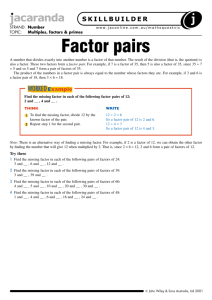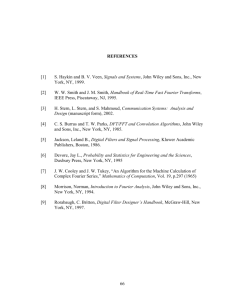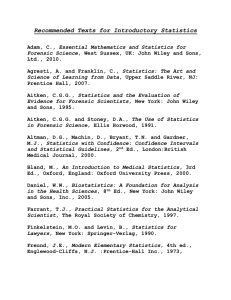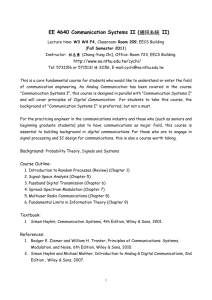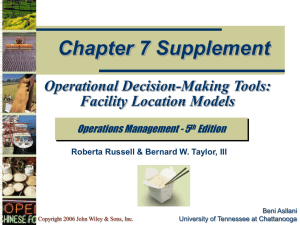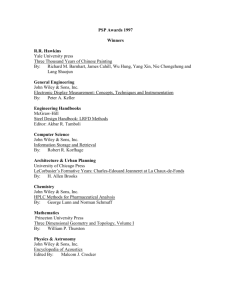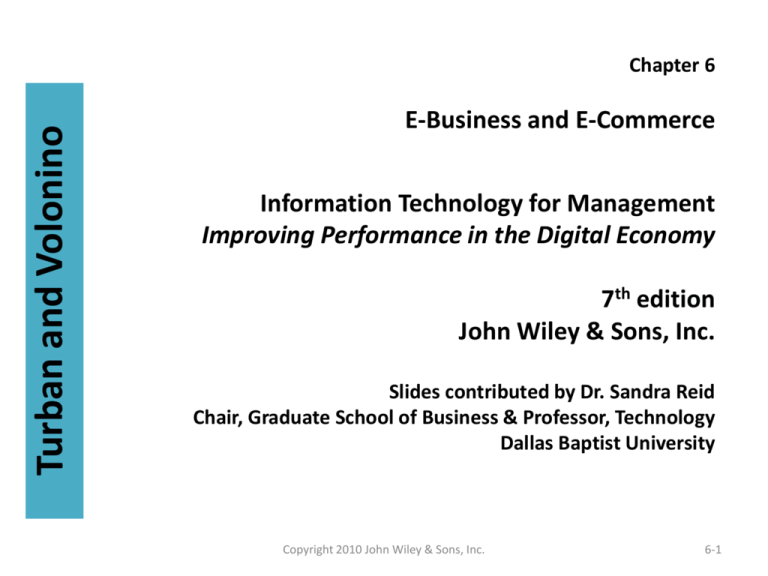
Turban and Volonino
Chapter 6
E-Business and E-Commerce
Information Technology for Management
Improving Performance in the Digital Economy
7th edition
John Wiley & Sons, Inc.
Slides contributed by Dr. Sandra Reid
Chair, Graduate School of Business & Professor, Technology
Dallas Baptist University
Copyright 2010 John Wiley & Sons, Inc.
6-1
Chapter Outline
6.1 Overview of E-Business and E-Commerce
6.2 Major EC Mechanisms
6.3 Business-to-Consumer Applications
6.4 Business-to-Business Applications
6.5 Major Models of E-Business: From EGovernment to C2C
Copyright 2010 John Wiley & Sons, Inc.
6-2
Chapter Outline (cont’d)
6.6 E-Commerce Support Services: Payment and
Order Fulfillment
6.7 Ethical and Legal Issues in E-Business
6.8 Managerial Issues
Copyright 2010 John Wiley & Sons, Inc.
6-3
Learning Objectives
1. Describe electronic commerce, its scope, benefits,
limitations, and types.
2. Explain how online auctions and bartering work.
3. Understand the major applications of business-to-consumer
commerce, including service industries and the major issues
faced by e-tailers.
4. Describer business-to-business applications.
5. Explain why intrabusiness and B2E are considered ecommerce.
Copyright 2010 John Wiley & Sons, Inc.
6-4
Learning Objectives cont’d
6. Describe e-government activities and consumer-toconsumer e-commerce.
7. Identify the e-commerce support services,
specifically payments and logistics.
8. Understand the importance and activities of online
advertising.
9. Identify and describe ethical and legal issues
relating to e-commerce.
Copyright 2010 John Wiley & Sons, Inc.
6-5
• Problem – Leader & target for Compaq.
Losses exceed $100 million.
• Solution – Rapid expansion with selling via
online.
• Result – Leading systems provider in US;
second worldwide. Fortune’s top 5 “Most
Admired” companies since 1999.
By-product – sell refurbished Dell computers.
Copyright 2010 John Wiley & Sons, Inc.
6-6
Dell’s Vast Customer Base
Business-to-Business
Dell becomes British Airways' preferred partner
Intel invests $23 million in three Indian firms
Copyright 2010 John Wiley & Sons, Inc.
6-7
Dell’s Vast Customer Base – cont’d
How Dell Does IT: Order Management
Training services
Online self-learning about Dell products
along with IT & management topics
Copyright 2010 John Wiley & Sons, Inc.
6-8
6.1 Overview of E-Business and E-Commerce
E-Business / E-Commerce
Copyright 2010 John Wiley & Sons, Inc.
6-9
e-commerce
or
e-business
E-commerce describes the process of buying, selling, transferring, or
exchanging products, services, and/or information via computer
networks, including the Internet.
E-business refers to a broader definition of e-commerce, not just the
buying and selling of goods and services, but also servicing customers,
collaborating with business partners, conducting e-learning, and
processing electronic transactions.
E-Business: degree of digitization
• Electronic commerce can take several forms
depending on the degree of digitization (the
transformation from physical to digital).
• The degree of digitization relates to:
– the product (service) sold
– the process
– the delivery agent (or intermediary).
• Partial vs. pure Electronic Commerce
– Buying books from Amazon
Click-&-mortar vs Brick-&-mortar organizations
More shoppers proceed to
checkout online…………
Copyright 2010 John Wiley & Sons, Inc.
6-12
E-commerce in our company
(Source:
Drawn by E.
Turban)
Copyright 2010 John Wiley & Sons, Inc.
6-13
Online Advertisers, Marketers & Students
Powerstudents.com
Copyright 2010 John Wiley & Sons, Inc.
6-14
E-Business – Transaction Types
E-commerce transactions can be done between
various parties.
• Business-to-business (B2B): Both the sellers and the buyers are
business organizations
• Collaborative commerce (c-commerce): In c-commerce,
business partners collaborate electronically
• Business-to-consumers (B2C): The sellers are organizations, and
the buyers are individuals (e-tailing)
• Consumers-to-businesses (C2B): Consumers make known a
particular need for a product or service, and suppliers compete
to provide it
E-Business – Transaction Types (Continued)
• Consumer-to-consumer (C2C): Individuals sell products or
services to other individuals
• Intrabusiness (intraorganizational) commerce: An organization
uses EC internally to improve its operations. A special case is
known as B2E (business to its employees)
• Government-to-citizens (G2C): A government provides services
to its citizens via EC technologies, or to other government units
(G2G) or to businesses (G2B)
• Mobile commerce (m-commerce): When e-commerce is done
in a wireless environment
E-commerce business models
•
•
•
•
•
Affiliate marketing
Bartering online and e-classifieds (e.g. craigslist.com)
Deep Discounters
Electronic marketplaces and exchanges
Electronic tendering systems
– Use the mechanism of reverse auctions
•
•
•
•
•
•
Find-the-best-price / Name-your-own price
Online auctions
Group purchasing (e-co-ops)
Information brokers
Membership
Online direct marketing
– Direct selling to customers; most efficient for digital products
•
•
•
•
Product customizations (build-to-order)
Supply-chain providers / improvers
Value chain integrators / service providers
Social commerce (e.g. Google APIs )
A framework for E-commerce
(Source:
Drawn by E.
Turban)
Copyright 2010 John Wiley & Sons, Inc.
6-18
EC: benefits and limitations
• Benefits to Organizations:
– Expands marketplace
– Efficient procurement
– Eliminates marketing costs
– Decrease the cost of digital
products and services
– Reduces inventory costs (pull
system)
– Enables niche markets
• Benefits to Consumers:
– Less expensive products
– More choices
– Shop from anywhere, anytime
– Customized products
– Work and study from home
– Interact and exchange ideas
• Technological limitations:
– Lack of universally accepted
standards for quality and
security
– Telecommunication bandwidth
– Integration (legacy applications)
– Accessibility
• Other limitations:
– Legal and regulatory issues
– Measurement inability
– Lack of trust to faceless
transactions
– Lack of critical mass
6.2 IS Major EC Mechanisms
Copyright 2010 John Wiley & Sons, Inc.
6-20
EC mechanisms
•Electronic market (e-marketplace)
•Electronic catalogs
•Consist of a product database, a directory, search capabilities,
presentation function. An electronic catalog can be static or
dynamic, standard or customized.
•Electronic auctions (e-Auctions)
•Forward auctions: Items are placed at sites for auction and
buyers bid continuously for the items (e.g. eBay.com).
•Reverse auctions: Suppliers are invited to submit bids.
•Auctions are used in B2C, B2B, C2B, e-government, and C2C commerce
•Bartering online
•Electronically supported exchange of goods without
monetary transactions
Electronic Catalogs
All of Your Suppliers’ Products in
One Online Catalog
Copyright 2010 John Wiley & Sons, Inc.
6-22
E-Auctions
Copyright 2010 John Wiley & Sons, Inc.
6-23
E-Classifieds
stores
eBay case study
business
Copyright 2010 John Wiley & Sons, Inc.
6-24
Bartering & Negotiations
The New Age of Bartering
Copyright 2010 John Wiley & Sons, Inc.
6-25
6.3 Business-to-Consumer Applications
Copyright 2010 John Wiley & Sons, Inc.
6-26
Business-To-Consumer – B2C
• Electronic retailing (e-tailing) is the direct sale of products through
electronic storefronts or electronic malls, usually designed around
an electronic catalog format and/or auctions.
– Electronic Storefronts. Hundreds of thousands of solo storefronts can
be found on the Internet, each with its own Internet name and EC
portal, such as Home Depot, The Sharper Image, or Wal-Mart.
– Electronic mall, also known as a cybermall or e-mall, is a collection of
individual shops under one Internet address. The basic idea of an
electronic mall is the same as that of a regular shopping mall—to
provide a one-stop shopping place that offers many products and
services.
Customer Service Life Cycle
• Phase 1: Requirements
– Assist customer determine needs
• Phase 2: Acquisition
– Help customer acquire product or service
• Phase 3: Ownership
– Support customer (e.g. newsletters, online subscription
renewal)
• Phase 4: Retirement
– Help client dispose of product
Electronic Storefronts
Copyright 2010 John Wiley & Sons, Inc.
6-29
Electronic Malls
shopping
Copyright 2010 John Wiley & Sons, Inc.
6-30
Amazon – King of E-Tailing
Jeff Bezos: The Wizard Of Web Retailing
Last Founder Standing
The Future of Reading
America's Best Leaders: Jeff Bezos,
Amazon.com CEO
The founder of the massive online retailer
is a true Internet pioneer
Copyright 2010 John Wiley & Sons, Inc.
6-31
Online Job Market
Copyright 2010 John Wiley & Sons, Inc.
6-32
Travel Services
Copyright 2010 John Wiley & Sons, Inc.
6-33
Real Estate Online
Copyright 2010 John Wiley & Sons, Inc.
6-34
E-tailing Issues – B2C
The concept of retailing and e-tailing implies the sale of goods and/or
services to individual customers. The following are the major issues
faced by e-tailers that may be handled and supported by IT tools:
•
•
•
•
•
Resolving channel conflict: A firm’s distribution channels compete with each other
and with the firm.
Resolving conflicts within click-and-mortar organizations. When an established
company decides to sell direct online, it may create a conflict within its existing
operations in areas such as pricing, services, allocation of resources and logistical
support.
Organizing order fulfillment and logistics. E-tailers face a difficult problem of how
to ship small quantities to a large number of buyers.
Determining viability and risk of online e-tailers. How long does a company
operate while losing money and how will it finance the losses.
Identifying appropriate revenue models. It is necessary to identify appropriate
revenue/business models.
6.4 B2B Applications
Copyright 2010 John Wiley & Sons, Inc.
6-36
Business-To-Business
• B2B business models
– Sell-Side Marketplaces: organizations attempt to sell their
products or services to other organizations electronically, from
their own private e-marketplace.
– Buy-Side Marketplaces: organizations attempt to buy needed
products or services from other organizations electronically,
usually from their own private e-marketplace. One buy-side
model is a reverse auction. Here, a company that wants to buy
items places a request for quotation (RFQ) on its Web site, or in
a third-party bidding marketplace.
Business-To-Business
• Electronic Exchanges are E-marketplaces in which there are many
sellers and many buyers.
– Vertical distributors for direct materials: These are B2B marketplaces where direct
materials (materials that are inputs to manufacturing) are traded in an environment of
long-term relationship, known as systematic sourcing.
– Vertical exchanges for indirect materials: Here indirect materials in one industry are
purchased on an “as-needed” basis (called spot sourcing). Buyers and sellers may not know
each other. In such vertical exchanges, prices are continually changing, based on the
matching of supply and demand.
– Horizontal distributors: These are “many-to-many” e-marketplaces for indirect (MRO)
materials, such as office supplies, used by any industry. Prices are fixed or negotiated in
this systematic sourcing-type exchange.
– Functional exchanges: Here, needed services such as temporary help or extra space are
traded on an “as-needed” basis (spot sourcing). Prices are dynamic, and they vary
depending on supply and demand.
ChemConnect Case Study
ChemConnect
Copyright 2010 John Wiley & Sons, Inc.
6-39
6.5 Major Models of E-Business:
From E-Government to C2C
Copyright 2010 John Wiley & Sons, Inc.
6-40
E-Government to C2C
• B2E – organizations disseminate information to employees
over company intranet.
• E2E – employees communicate with each other. I.e.: goods
& services bought & sold among fellow employees.
• SBU/SBU – company owned dealerships buy goods &
services from main company. Improves internal supply
chain operations.
• E-Collaborative – digital technologies that enable
collaboration.
• E-Government – delivers information & services to citizens,
business partners & suppliers. I.e.: G2C, G2B, G2G.
Copyright 2010 John Wiley & Sons, Inc.
6-41
6.6 E-Commerce Support Services:
Payment, & Order Fulfillment
Copyright 2010 John Wiley & Sons, Inc.
6-42
E-commerce support services
(Source: Drawn by E. Turban.
2010 John Wiley & Sons, Inc.
Based on S.Y. Choi et al., 1997,Copyright
p. 18.)
6-43
Market Research Online
Copyright 2010 John Wiley & Sons, Inc.
6-44
Electronic payment
Copyright 2010 John Wiley & Sons, Inc.
6-45
How e-credit cards work
(The numbers 1-9 indicate the sequence of activities.)
(Source: Drawn by E. Turban.)
Copyright 2010 John Wiley & Sons, Inc.
6-46
The use of a mobile phone as an e-wallet
(Source: Koichi Kamoshida/Getty Images.)
Copyright 2010 John Wiley & Sons, Inc.
6-47
Order fulfillment and the logistics system
(Source: Turban et al., Electronic Commerce: A Managerial
Perspective 2008, Exhibit 13.2, p. 591).Copyright 2010 John Wiley & Sons, Inc.
6-48
6.7 Ethical & Legal Issues in E-Business
Copyright 2010 John Wiley & Sons, Inc.
6-49
Ethical and Legal Issues in E-Business
• Privacy
• Web tracking (cookies)
• Disintermediation and reintermediation
– Infomediaries
• Internet fraud
• Domain names
– Cybersquatting
• Taxes and other fees
• Intellectual property protection
Ethical and Legal Issues in E-Business
•
•
•
•
Privacy
Web tracking (cookies)
Loss of jobs
Disintermediation and reintermediation
– (a) matching and information providing; (b) value-added
services e.g. consulting (Infomediaries)
• Internet fraud
• Domain names
– Cybersquatting
• Taxes and other fees
• Intellectual property protection
6.8 Managerial Issues
Copyright 2010 John Wiley & Sons, Inc.
6-52
Managerial Issues
• E-Commerce failures – common. Solid business
analyses a must.
• Failed initiatives within an organization.
• Success stories & lessons learned should be shared.
• Managing resistance to change.
• Integration into business overall.
• Lack of qualified personnel & outsourcing.
• Managing impact on organization.
• Alliances can be very helpful & productive.
• Choosing appropriate strategy.
Copyright 2010 John Wiley & Sons, Inc.
6-53
Copyright 2010 John Wiley & Sons, Inc.
All rights reserved. Reproduction or translation of this
work beyond that permitted in section 117 of the 1976
United States Copyright Act without express permission
of the copyright owner is unlawful. Request for further
information should be addressed to the Permission
Department, John Wiley & Sons, Inc. The purchaser may
make back-up copies for his/her own use only and not
for distribution or resale. The Publisher assumes no
responsibility for errors, omissions, or damages caused
by the use of these programs or from the use of the
Information herein.
Copyright 2010 John Wiley & Sons, Inc.
6-54

